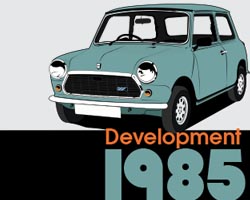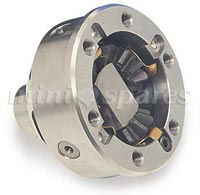
Development
During 1985 which was nearly 25 years after the original four star wheel mini concept, the idea was applied to rear wheel drive applications when David Hiron was approached by British trial car champion Julian Fack to solve the problem of persistent diff.
27/07/2017
Development
During 1985 which was nearly 25 years after the original four star wheel mini concept, the idea was applied to rear wheel drive applications when David Hiron was approached by British trial car champion Julian Fack to solve the problem of persistent diff bevel gear and carrier failure on the Ford diff as fitted to the Escort and lotus Cortina’s.
It was basic proven engineering that the addition of the 2 extra bevel gears would increase the capacity of the diff to transmit driving torque.This does not effect the cross axle torque transfer and is therefore the same as a standard diff.

Equally the tendency for the bevel gears to seize to the cross pin is not reduced by any significant amounts unless the lubrication characteristics of the cross pin and bevels are improved and this can only be achieved by applying modern material technology to the pin or bevels.
First usage
Hill climb exponent Peter Harper, put the first Ford diff developed and manufactured by David Hirons to good use by resetting most UK Hill Climb and sprint records for the Clubman class with his Vision sports racing car. The proof of the quality and performance of the diff is shown by many of these records remaining unbroken for many years later.
The main advantage this Ford unit gave was the ability to harness the cars full power when warming tyres and carrying out repeated standing starts. This was because the diff uses a very special cross pin arrangement to overcome the lubrication problems outlined previously.
This had obviously worked out well in the trials car applications as according to Julian Fack “The X pin diff has become synonymous with axle reliability in the sport and a sales feature when cars are advertised for resale”.
Application for the Mini
During 1993 a decision was made to resurrect the manufacture of the 4 star diff and reapply the technology to the mini. When Timo Makinen was discussing his plans for the 1994 Monte Carlo Rally with automotive engineer Tom Seal he was excited at the prospect of running the unit on the rally increasing reliability without the handling problems of the Limited slip diff. A pre production unit was fitted for use on the ill-fated Monte Carlo car where a fuel problem ruled them out of the event. The car was entered the following year and driven by Keith Bird without any hitches proving the worth of the Cross pin which had now been put into production by David Hirons with exclusive marketing done by Mini Spares. The product was protected under UK and European design laws and copyright and now manufactured by Mini Spares Centre under licence. Importation rules regarding vehicles are very specific: Only those over 25 years in age may be brought in to the USA without compilance to Federal Motor Vehicle Safety Standards (FMVSS).
Author
stuart
